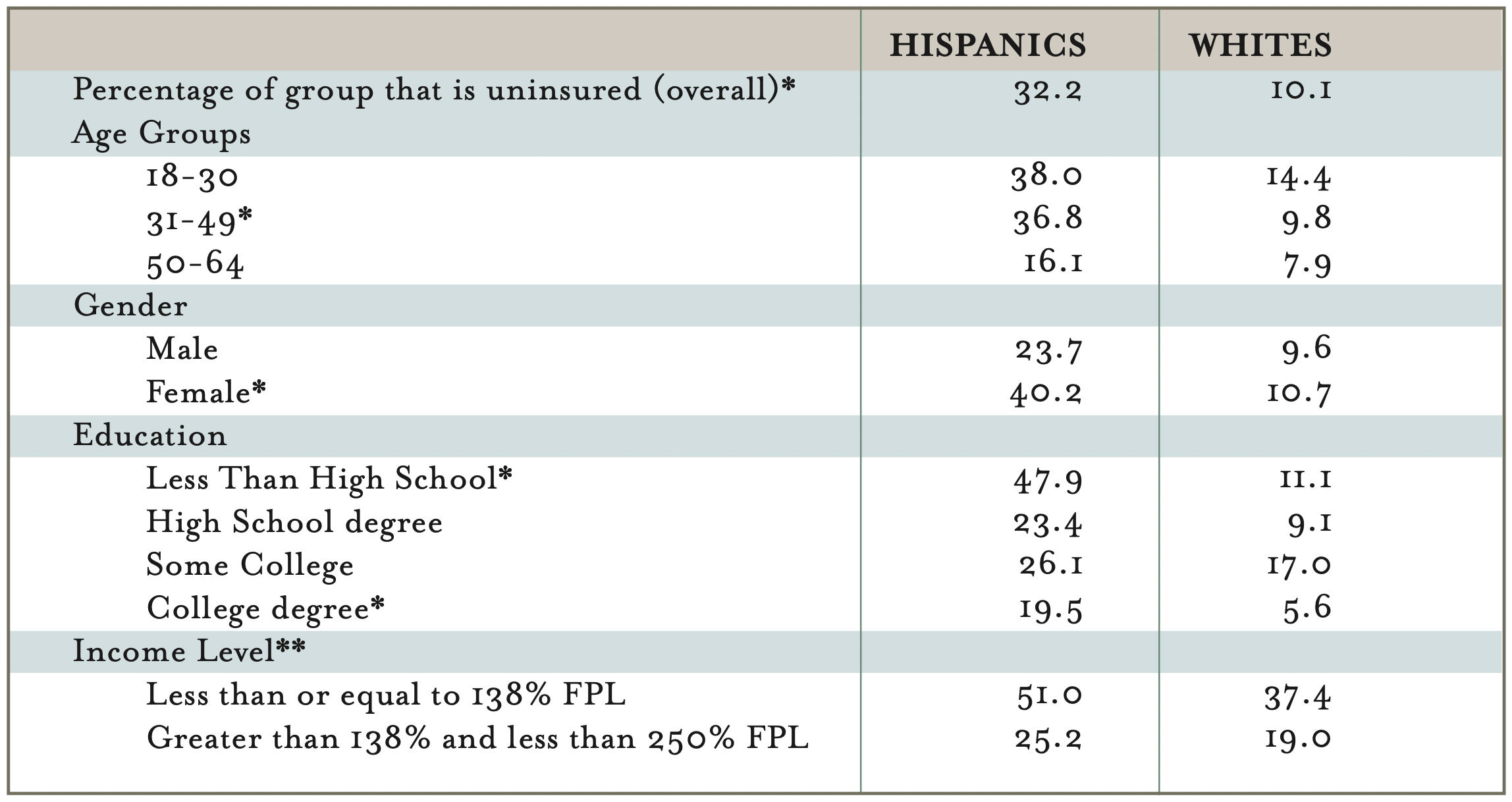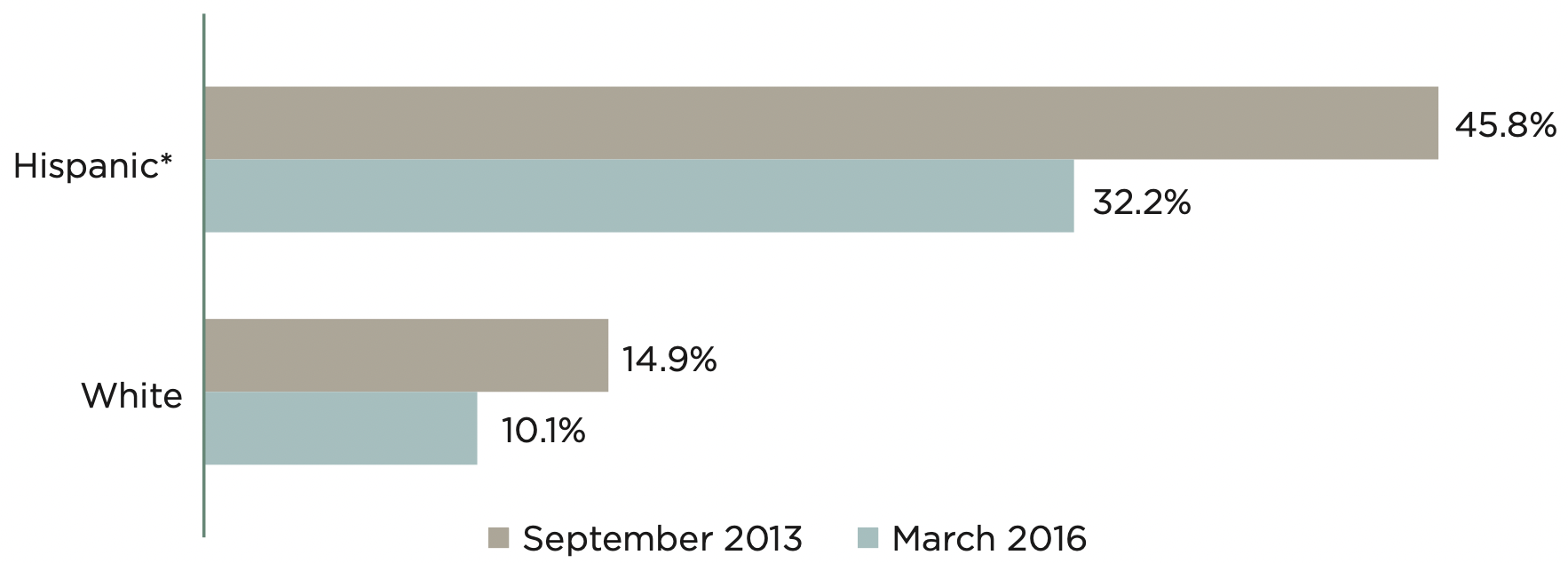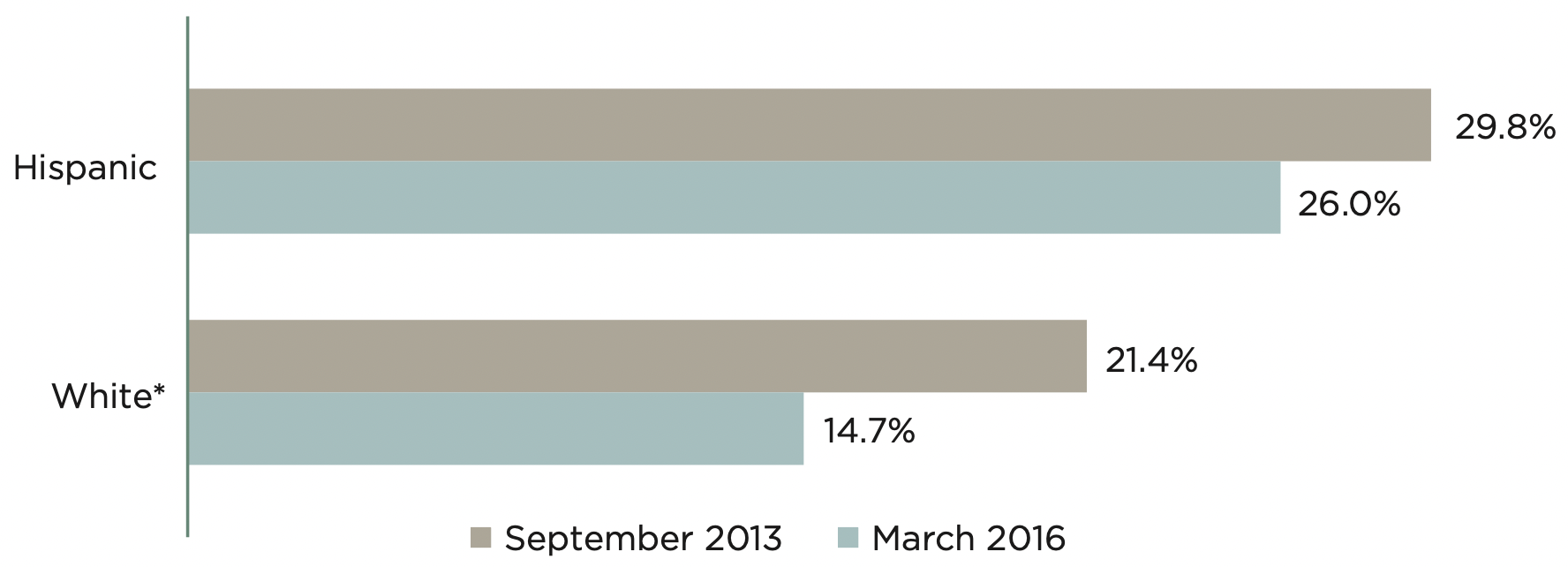HRMS Issue Brief #22: The Impact of the Affordable Care Act on Adult Hispanics in Texas

Table of Contents
Author(s)
Elena M. Marks
Senior Fellow in Health PolicyVivian Ho
James A. Baker III Institute Chair in Health EconomicsShao-Chee Sim
Vice President for Applied Research, Episcopal Health FoundationShare this Publication
- Print This Publication
- Cite This Publication Copy Citation
Marks, E., Ho, V., and Sim, S. James A. Baker III Institute for Public Policy, Rice University, The Episcopal Health Foundation, Health Reform Monitoring Survey – Texas, Issue Brief #22: The Impact of the Affordable Care Act on Adult Hispanics in Texas.
A central goal of the Affordable Care Act (ACA) is to improve access to affordable health insurance coverage for millions of Americans. Hispanics make up 39% of the Texas population and historically have accounted for a disproportionate share of uninsured Texans. Before the implementation of the major coverage expansion provisions of the ACA, census data from 2012 indicated that 39% of Texas Hispanics were uninsured, compared to 17% of Whites and 22% of Blacks. The ability of Hispanics to obtain affordable health insurance under the ACA is crucial if we are to reduce the overall rate of uninsured residents in Texas. The purpose of this brief is to explore the changes in the rates of uninsurance among Hispanics ages 18-64 between 2013 and 2016, to understand the demographic profile of uninsured Hispanics, and to recommend strategies for increasing coverage for Hispanics going forward.
Our analysis shows that nearly one-third of Hispanic adults, compared to only one-tenth of White adults, remained uninsured at the conclusion of the third Marketplace open enrollment period. More than half of uninsured Hispanics surveyed had incomes below 139% of the federal poverty line. Those with incomes below 100% of the federal poverty level fall into a “coverage gap” created as a result of the state’s refusal to expand Medicaid. In addition to the “coverage gap,” there are an estimated 780,000 uninsured Hispanics ages 18-64 who are undocumented and could not access affordable coverage under the ACA. We conclude that an estimated 920,000 uninsured Hispanics ages 18-64 still have the opportunity to gain coverage through the ACA’s Marketplace as well as other private insurance plans. More targeted outreach and enrollment efforts should continue to focus on this population.
About the Survey
The Health Reform Monitoring Survey (HRMS) is a quarterly survey of adults ages 18-64 that began in 2013. It is designed to provide timely information on implementation issues under the ACA and to document changes in health insurance coverage and related health outcomes. HRMS provides quarterly data on health insurance coverage, access, use of health care, health care affordability, and self-reported health status. The HRMS was developed by the Urban Institute, conducted by GfK, and jointly funded by the Robert Wood Johnson Foundation, the Ford Foundation, and the Urban Institute. Rice University’s Baker Institute and The Episcopal Health Foundation are partnering to fund and report on key factors about Texans obtained from an expanded, representative sample of Texas residents (HRMS-Texas). The analyses and conclusions based on HRMS-Texas are those of the authors and do not represent the view of the Urban Institute, the Robert Wood Johnson Foundation or the Ford Foundation. Information about the sample demographics of the cohort is available in Issue Brief #1. This Issue Brief is a summary of data extracted from the HRMS Surveys in Texas administered between September 2013 and March 2016. We will continue to report on survey data through additional Issue Briefs and future surveys.
Characteristics of Uninsured Hispanics and Uninsured Whites in 2016
Table 1 below shows that 32 percent of Hispanics ages 18 to 64 remain uninsured in March 2016, compared to only 10 percent of Whites. Rates of uninsurance between Hispanics and Whites across age, gender, educational attainment, and income levels are also reported.
Table 1 — Uninsured Rates for Hispanic and White Population by Demographic Characteristics, March 2016

** Uninsured rates for income levels above 250% FPL are not reported, due to insufficient sample size among Hispanics.
The absolute difference in uninsured rates between Hispanics and Whites in Table 1 appear large for all subgroups, but only certain disparities are statistically significantly different. Differences in rates of uninsured by ethnicity are significantly different for persons ages 31 to 49, females, those lacking a high school education, and those with a college degree. Other subgroups might exhibit significant differences with a larger sample size. Over one-third of both Hispanics and Whites with incomes less than or equal to 138% FPL ($16,242 for an individual) are uninsured. These rates would fall significantly if Texas adopted the Medicaid expansion under the ACA. Uninsured rates among Hispanics and Whites between 139 and 250% of the FPL are 25% and 19% respectively. These relatively high rates suggest that even with subsidies Marketplace insurance plans may be too costly for these individuals.
Changes in Rates of Uninsurance and Affordability of Health Services among Hispanics from 2013 to 2016
Chart 1 — Percentage Uninsured, Texans Ages 18-64, September 2013 and March 2016

As we reported in Issue Brief #21, all racial/ethnic groups experienced decreases in their rates of uninsurance between September 2013, before the opening of the ACA’s Health Insurance Marketplace, and March 2016, after the Marketplace’s third open enrollment period. Chart 1 shows the changes in rates of uninsurance for Hispanics and Whites over this time period. The data show that the rate of uninsured Hispanics dropped by 13.6 percentage points, a 30% decrease. During that same period, the rate of uninsured Whites dropped by only 4.8 percentage points, a 32% decrease. While both groups experienced large decreases in the rates of uninsurance, and the percentage point drop among Hispanics was much larger than among Whites, the disparity between the two groups remains striking. After three open enrollment periods of the Marketplace, the rate of uninsurance among Hispanics is still three times that of their White counterparts. Nearly one-third of Hispanic adults, compared to only one-tenth of White adults, remain uninsured.
Chart 2 — Percentage of Adult Texans Having Problems Paying Medical Bills, September 2013 and March 2016

We also surveyed Whites and Hispanics to determine the changes, if any, in their reported abilities to pay medical bills in 2013 and 2016. Specifically, we asked respondents whether they or anyone in their family had problems paying or were unable to pay any medical bill within the year. As shown in Chart 2 below, Hispanics reported that they had trouble paying medical bills more often than their White counterparts in September 2013 and again in March 2016. Over the period, however, Whites experienced a statistically significant reduction in the percentage of people having trouble paying bills (31%) while Hispanics reported a relatively slight and not statistically significant drop (13%). The ability to pay medical bills is correlated with insurance status, so the disparity between Hispanics and Whites in 2013 and 2016 is likely due to the differences in the two group’s rates of insurance coverage.
Marketplace Enrollment by Hispanics
Chart 3 — Health Insurance Enrollment Through the Marketplace in Texas, March 6

As the above data show, prior to the opening of the ACA Marketplace, Hispanic Texans were three times as likely to be uninsured as their White counterparts and almost twice as likely to have trouble paying medical bills. Hispanics therefore had the most to gain through the new coverage provisions of the ACA. Chart 3 below shows the enrollment in Marketplace plans by adult Hispanic and White Texans as of March 2016. Hispanics enrolled in Marketplace plans at twice the rate of their White counterparts. This indicates that the Marketplace is an important source of affordable health insurance coverage for Hispanics.
Conclusions
Since the opening of the ACA’s Marketplace in late 2013, there have been significant decreases in the rates of uninsured Hispanics ages 18-64—from 46% to 32% uninsured, a 30% drop. During this period, many Hispanics have purchased insurance through the Marketplace, with 21% of all insured Hispanics being covered by Marketplace plans as of March 2016, compared to only 11% of Whites. Notwithstanding these gains, almost one-third of Hispanics ages 18-64, which we estimate to be approximately two million people, remain uninsured. We developed this estimate by applying the 32% uninsured rate among Hispanics to 6.4 million to the estimated total Hispanic population ages 18-64 as reported in the 2014 census data.
While there is still progress to be made in covering more Hispanics, there are two factors that contribute to this stubbornly high rate and large number of uninsured Hispanics.
First, in our survey sample, more than half of uninsured Hispanics have incomes below 139% of the federal poverty level. Many in this income category fall within the “coverage gap.” They earn too much to qualify for traditional Medicaid (which only covers parents with annual incomes up to $3,000 and does not cover non-disabled childless adults at all) but not enough to qualify for ACA Marketplace subsidies (which are only available to people above 100% of the federal poverty level). We estimated that about 300,000 Hispanics ages 18-64 fall into the coverage gap. We arrived at our estimate by applying the share of Hispanics out of the Texas population ages 18-64 (38%) to the Kaiser Family Foundation’s estimated total coverage gap population in Texas of 766,000. Because Texas opted not to expand Medicaid, this population lacks access to affordable individual insurance coverage. Unless Texas expands Medicaid or devises an alternative system of coverage, these 300,000 Hispanics will likely remain uninsured.
Second, some of the uninsured Hispanics are likely to be undocumented immigrants. There is no opportunity for undocumented immigrants to obtain affordable coverage through the ACA, including in the states where Medicaid has been expanded. We estimate that the number of undocumented Hispanic Texans ages 18-64 is approximately 780,000. This estimate is derived from the application of census data to estimates of undocumented Texans compiled by The Migration Policy Institute (TMPI). TMPI estimates that there are approximately 1.3 million undocumented Texas residents from Mexico and/or Central America. According to 2014 census data, 60% of Hispanic Texans are aged 18-64. We arrived at our estimate by applying this factor to the TMPI data.
Notwithstanding the undocumented Hispanics and those falling into the coverage gap, there is still an opportunity for an estimated 920,000 uninsured Hispanics ages 18-64 to gain coverage through the ACA’s Marketplace as well as other private insurance plans. We developed this estimate by removing from the estimated two million uninsured Hispanics ages 18-64 the 300,000 Hispanics who fall into the coverage gap and the 780,000 undocumented Hispanics.
We encourage those engaged in outreach and enrollment efforts to continue to focus on the nearly one million Hispanic Texans who are uninsured but eligible for coverage. The Hispanic population is growing at a faster rate than the state average which makes it increasingly important to the entire state that Hispanics gain affordable insurance coverage. In the long term, serious consideration should be focused on maintaining affordable premiums in the Marketplace for between 100 and 250% of the FPL. Relatively high rates of uninsurance for this subgroup for both Hispanics and Whites suggest that Marketplace plans may be too costly for those living on limited incomes.
Looking Ahead
The full impact of the ACA on the Hispanic population will not be known for some time. As the implementation of the ACA continues and a second enrollment period begins later this year, the coverage gap between Hispanic and White adults may be reduced. We will continue to survey and report on the HRMS-Texas survey panel to examine these changes in the future.
Methodology
Each quarter’s HRMS sample of nonelderly adults is drawn from active KnowledgePanel® members to be representative of the US population. In the first quarter of 2013, the HRMS provided an analysis sample of about 3,000 nonelderly (age 18–64) adults. After that, the HRMS sample was expanded to provide analysis samples of roughly 7,500 nonelderly adults, with oversamples added to better track low-income adults and adults in selected state groups based on (1) the potential for gains in insurance coverage in the state under the ACA (as estimated by the Urban Institute’s microsimulation model) and (2) states of specific interest to the HRMS funders.
Although fresh samples are drawn each quarter, the same individuals may be selected for different rounds of the survey. Because each panel member has a unique identifier, it is possible to control for the overlap in samples across quarters.
For surveys based on Internet panels, the overall response rate incorporates the survey completion rate as well as the rates of panel recruitment and panel participation over time. The American Association for Public Opinion Research (AAPOR) cumulative response rate for the HRMS is the product of the panel household recruitment rate, the panel household profile rate, and the HRMS completion rate—roughly 5 percent each quarter.
While low, this response rate does not necessarily imply inaccurate estimates; a survey with a low response rate can still be representative of the sample population, although the risk of nonresponse bias is, of course, higher.
All tabulations from the HRMS are based on weighted estimates. The HRMS weights reflect the probability of sample selection from the KnowledgePanel® and post-stratification to the characteristics of nonelderly adults and children in the United States based on benchmarks from the Current Population Survey and the Pew Hispanic Center Survey. Because the KnowledgePanel® collects in-depth information on panel members, the post-stratification weights can be based on a rich set of measures, including gender, age, race/ethnicity, education, household income, homeownership, Internet access, primary language (English/Spanish), residence in a metropolitan area, and region. Given the many potential sources of bias in survey data in general, and in data from Internet-based surveys in particular, the survey weights for the HRMS likely reduce, but do not eliminate, potential biases.
The design effect for the Texas data in March 2016 is 2.7005 and the MOE is +/- 4.1% at the 95% CI. The survey fielded from March 1-22, 2016.


